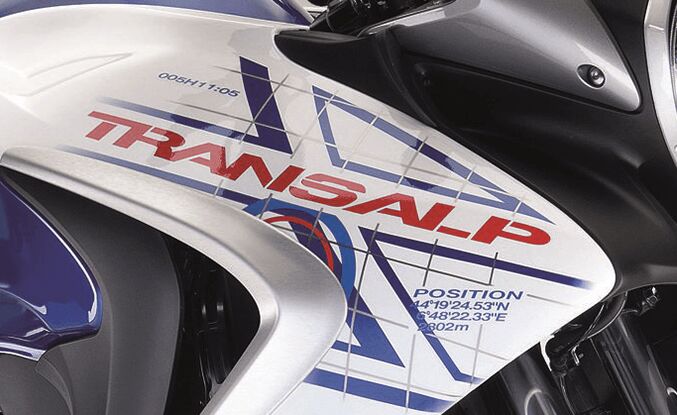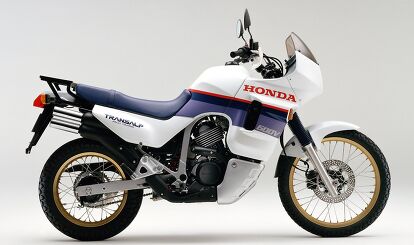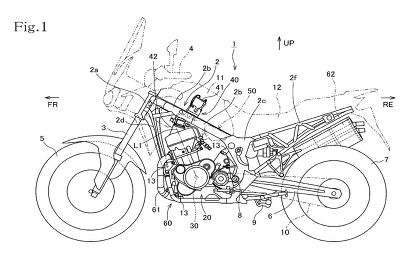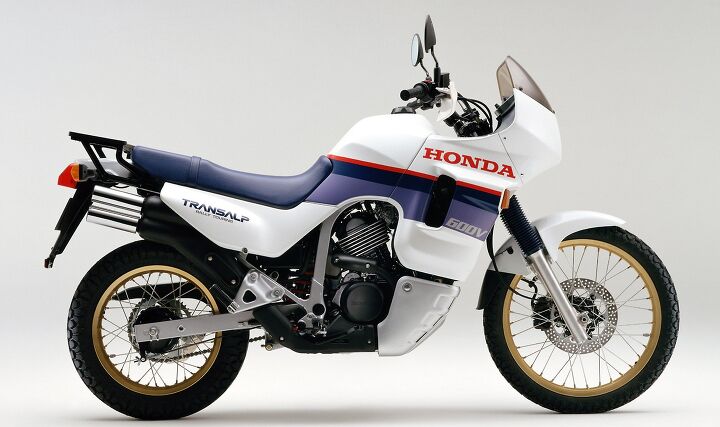Rumor Check: Is Honda Preparing Mid-Sized Adventure Bike Called the Transalp?

A smaller Africa Twin?
It didn’t take long after Honda debuted the CRF1000L Africa Twin in 2015 before we started wondering when Honda would produce a mid-sized version. Fast forward several years including one model update to make it a CRF1100L, and we still don’t have a true mid-sized adventure bike from Honda.
Of course, we do have the CB500X and NC750X, two solid motorcycles in their own right. But they are both more suitable as streetbikes than off-road warriors like the KTM 890 Adventure, Yamaha Ténéré 700, BMW F850GS, Triumph Tiger 900, or Suzuki V-Strom 650XT. Even Aprilia, which doesn’t currently have a “large” adventure bike, is expected to launch a new Tuareg using the same parallel-Twin engine as the Tuono and RS 660.
As the years go by, Honda’s absence in the competitive mid-sized adventure-touring segment becomes increasingly surprising. Naturally, there have been rumors that a smaller Africa Twin is on the way, so let’s examine some of the more common ones floating around.
Rumor: Honda’s middleweight adventure-tourer will be called the Transalp
Like “Africa Twin,” the “Transalp” name has roots in Honda dual sports from the ’80s. The Transalp actually came first, debuting in 1986 as the XL600V with a 583cc 52° liquid-cooled V-Twin, while the Africa Twin XRV650 followed in 1988.
Of the two, the Africa Twin was perceived to be the more hardcore model, thanks in large part to the 1990 model that saw the displacement bumped to 742cc and a close connection to Honda’s Paris-Dakar-winning NXR-750. That lineage continues to the modern CRF1100L Africa Twin.
In comparison, the Transalp was perceived as being more road-oriented despite a similar rally-style design. By 2000, the Transalp adopted the 647cc engine from the Deauville NT650V, and in 2008, saw a displacement increase to 680cc to match the Deauville NT700V.
The Transalp name got linked to rumors of a mid-sized Africa Twin after Honda filed a new trademark application for the name with the U.S. Patent and Trademark Office on Feb. 9 this year. Subsequent trademark applications were later filed in Japan, the Philippines, and the World Intellectual Property Office. Given the similar history between the two names, Transalp became an obvious candidate for a smaller Africa Twin.
What gives me pause are similar Honda trademark filings for the name “NT1100.” Honda filed a trademark application for NT1100 with the European Union Intellectual Property Office on Feb. 2, with a subsequent filing in Australia on Feb. 25.
That both names were filed at around the same time, but without overlapping IP offices suggests to me that the Transalp and NT1100 might be one and the same, but with different names for different markets. The original Transalp’s ties to the Deauville NT models further supports this theory. Instead of a mid-sized Africa Twin, the Transalp NT1100 may turn out to be a sport-touring model using the CRF1100L’s engine.
Of course, it’s possible they are two different models and the Transalp may still end up on a mid-sized Africa Twin. At this point, there’s not much evidence either way.
Rumor: Honda considered giving the Africa Twin a direct-injection engine
This second rumor sprang up in 2019 after patents emerged showing an Africa Twin-looking machine. The frame plus the dashed outline resemble the CRF1000L Africa Twin but the engine appeared to be completely different.
At the time, we were expecting Honda to release an updated Africa Twin, if for no other reason than to get it to meet Euro 5 regulations. When these patents popped up, it was assumed that they were to for this new Africa Twin.
The main focus of the patents was to incorporate an engine with direct injection. But instead of applying the technology to the existing CRF1000L engine, the patent shows a completely different powerplant. The patents describe a parallel-Twin with a 270° phased crankshaft, just like the existing engine, but instead of the CRF1000L’s Unicam valve train, it used a double overhead camshaft.
The engine cases were also markedly different from the existing Africa Twin engine, or any current Honda motorcycle engine, for that matter, suggesting it was a completely new powerplant.
We know now that Honda increased the Africa Twin’s displacement with a longer stroke, bringing it from 998cc to 1084cc. The cylinder head received some tweaking, the air intake was modified, and the fuel injectors were re-angled, but the engine was essentially an evolution of the existing mill instead of a clean-sheet design.
This, of course, was the obvious result. The Africa Twin’s engine was only a few years old, and Honda no doubt had a future Euro 5 update in mind during its development. It made no sense for Honda to completely abandon the engine after such a short time when a few adjustments would be enough to pass the stricter emission requirements.
If this was the plan all along, then what was the point of the direct injection project? The first patents were filed in Japan in 2018, but subsequent patents followed, including one filed Oct. 31, 2019 – a month after the CRF1100L was revealed.
Perhaps the direct injection engine wasn’t intended for the Africa Twin at all, but a whole new engine for the mid-sized adventure bike. A displacement somewhere in the 800cc-900cc range would be completely new for Honda, so it makes more sense for a brand new engine to be designed for the mid-sized model than for updating the existing Africa Twin.
This is all conjecture at this point, as there is no indication Honda has any plans for a mid-sized adventure bike beyond the NC750X or CB500X. That being said, it’s a highly-competitive segment that Honda currently has no real answer to, but probably should.
Become a Motorcycle.com insider. Get the latest motorcycle news first by subscribing to our newsletter here.

Dennis has been a part of the Motorcycle.com team since 2008, and through his tenure, has developed a firm grasp of industry trends, and a solid sense of what's to come. A bloodhound when it comes to tracking information on new motorcycles, if there's a new model on the horizon, you'll probably hear about it from him first.
More by Dennis Chung









































Comments
Join the conversation
The laydown, long stroke, NC engine, already has all the ingredients for a middle weight adv. Revs, and behaves, like a giant single, but without the clumsiness at either end of the powerband.
The latest NC has been slammed 30mm, making it a better pavement bike. But at the same time leaving space for a more off-pavement tuned sibling. Miserly fuel consumption and rock bottom cog per ground clearance, are great boons for the middle weight adv field.
Possible issue being Honda having problems keeping wheelbase short enough once angles are slacker and travel longer, as a longstroke laydown engine will invariably be long front-to-back.
Make a 750 c.c. middleweight to make the same power as an older 650, due to emission laws. Put quality suspension, keep the weight down and get ready for a world wide hit!